Hand-made crocheted napkins, sofa cushions, tablecloths for rectangular or round tables, as well as various types of organizers allow you to decorate and complement almost any interior.
Selection of materials and tools
The yarn and tools for work are selected based on the purpose of the finished product. Traditionally, tablecloths are knitted from cotton thread. For a classic tablecloth, the ideal option is plain mercerized cotton with a thread thickness of 400 to 600 m per 100 g.
Metal hooks of different sizes are suitable for working with such yarn. The diameter of the tool is selected individually, based on the specific knitting density and the yarn manufacturer's recommendations (they are indicated on the labels).
For example, for a thread with a thickness of 400 m/100 g, hooks from No. 1 to 2.5 are suitable. Thin yarn with a footage of 600 m/100 g can be knitted using hooks No. 0.5; 0.9; 1.25 or even 1.5 and 2.

The thinner the hook, the denser the fabric will be, and vice versa: the larger the caliber of the tool, the looser and softer the tablecloth will be. The sample should be measured only after WHT (wet heat treatment).
Cotton tends to shrink after washing, so only a completely dry sample will provide real figures for calculations. As an alternative to cotton, you can choose other yarn compositions, such as viscose, bamboo, linen, silk or mixed types of materials.
A crochet tablecloth for a rectangular table will be practical and durable if you knit it from synthetic thread (polyamide, microfiber). Such materials are easy to wash off dirt and keep their shape. However, you should not use acrylic, as it can stretch over time, fluff up and lose its attractive appearance.
The same recommendations will help you choose yarn for a tablecloth in a modern style, with the difference that there is greater freedom in choosing colors and textures. The total material consumption for a specific product can only be determined after weighing the sample. You need to calculate the area of the sample, compare it with the area of the future tablecloth and then calculate the amount of yarn.

For example: the sample has an area of 10x10 cm (100 cm2) and weighs 5 g, and the finished product should be 180 cm long and 160 cm wide (28800 cm2). If you divide the area of the tablecloth by the area of the sample, it turns out that the finished product will “fit” 288 samples of 5 g each. So, to knit the tablecloth, you will need 1440 g of yarn (provided that the density of the craftswoman remains the same as when knitting the sample).
Technique of crocheting a rectangular tablecloth for a table
Tablecloths with an openwork border, assembled from motifs, made with a fillet pattern, or with additional embroidery are considered classic. Usually these are single-color products made of natural material.
A crochet tablecloth for a rectangular table can also be more modern. In this case, it should have a completely different look: a minimum of patterns and a laconic design, bright colors (although simple basic shades are often used), a small number of openwork holes.

All possible options for making a rectangular tablecloth can be combined into 3 large groups:
- Knitting a whole piece of fabric.
- Combination of individual motifs.
- Formation of the central zone and attachment of the border.
Making a tablecloth the first way will be the easiest, it is ideal for beginner knitters. They may experience some difficulties at the very beginning of the work, as the first rows will be very long.
The advantage of this technique is that the size of the finished product is immediately visible, it can be measured and, if necessary, adjustments can be made. The first type of tablecloths includes products made with various nets, simple patterns, as well as models in the fillet technique.
Fillet patterns are a combination of empty (double crochet, 1 chain stitch) and filled cells (2 double crochets).A crochet tablecloth for a rectangular table using the filet crochet technique is crocheted quickly. There are many different patterns.
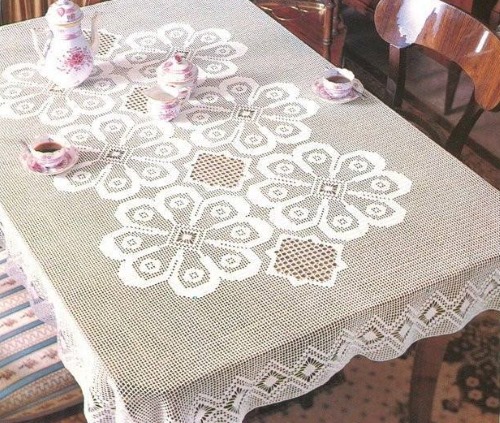
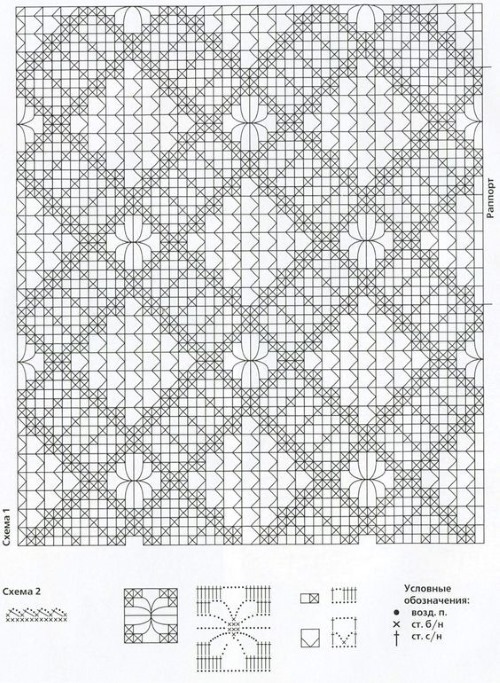
Some of them are a rapport of 10-30 loops and rows, which must be repeated to get a large canvas. Others include an ornament for the entire product and can have several hundred loops and rows. You can adapt monochrome embroidery patterns to knit an unusual and original tablecloth using the filet knitting technique.
The second method of knitting tablecloths is one of the most popular, since it is easiest to assemble a rectangular tablecloth from square motifs. But there are also other options: circles of different sizes, triangles, hexagons, octagons, stripes and irregularly shaped elements.
If the tablecloth is assembled from round modules, then motifs of 2 sizes are chosen. The main canvas consists of large circles, and the gaps are filled with small elements. When working with non-standard figures, it is necessary to think in advance about what shape the finished canvas will have.
To form perfectly even edges and corners, it is often necessary to knit halves and quarters of modules. Knitting a tablecloth from abstract motifs requires experience, perseverance, good spatial imagination and time.

Since the motifs are made separately, each has at least 2 ends. They need to be securely hidden at the end of the work so that the canvas looks whole and neat.
Many experienced craftsmen recommend using a needle for these purposes, rather than hiding the threads inside the crochet posts. If the ends of the threads are not hidden securely enough, they will quickly appear on the surface of the tablecloth after the first wash.
Do not burn the ends of the trimmed yarn. If we are talking about a natural material, it will not melt, but burn. However, even a synthetic thread should not be burned, since the melted ball will stand out on the canvas in color and texture (you will get a hard black lump).
Connecting the motifs into a single piece is an important moment. There are several ways to assemble modules into a tablecloth: sew separately knitted elements with a needle, use a crochet hook for the same purpose, or connect the motifs when knitting the last row.
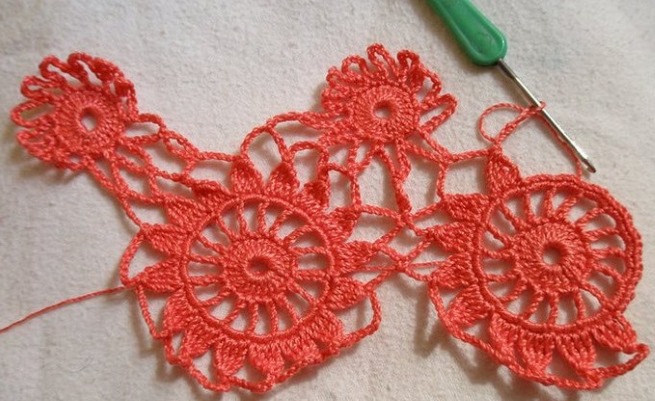
You can sew modules together with a needle or a crochet hook only when their last row has a clear outline or is a straight line. For example, the straight edges of a square, hexagon or octagon. All edges are the same size, they are easy to match and sew together.
First, the finished motifs are laid out on a flat horizontal surface with the wrong side up, adjacent elements are pinned and then sewn together. It is most convenient to sew the motifs into stripes and then connect them together. At the finishing stage, the seams on the finished tablecloth are ironed from the wrong side or simply steamed.
To connect the motifs during the knitting of the last row, you should choose patterns that end with a "picot". This element (loop) consists of 3 air loops that have one base.
To combine 2 motifs, you need to knit the 1st one completely, and attach the 2nd one to the first one as follows:
- knit 1st loop "pico";
- insert the hook into the picot of the 2nd motif and make a connecting post;
- finish knitting "picot" on the 1st motif (make the 3rd loop).
It is important to ensure that the tablecloth elements are correctly positioned so that all the "picots" are connected in pairs.
Sizes and shapes
A crochet tablecloth for a rectangular table should also have a rectangular shape, but its edges may be uneven. This happens when the fabric consists of round or polygonal motifs and there are no small elements to align the contour. Uneven edges are not considered a mistake, because there is no standard or ideal sample.
Tablecloths made of square motifs or connected by a single piece have clear contours. The edge is neat as a result of edging the finished product with several circular rows of single crochets. Then an openwork border is added or the simplest edging is left.
The product looks beautiful and appropriate only when it completely covers the table and hangs over its edges to a sufficient height (from 20 to 40 cm).
When calculating the length and width of the tablecloth, you need to add the overhang length, multiplied by 2, to the corresponding table parameters.
If the finished product will have very uneven edges, it is better to include longer overhangs in its size. In the case where all edges of the product will be decorated with fringe made of tassels, spirals or other long decor, it should be added to the total length of the overhang (so that the fringe does not start at the tabletop itself).
If the finished tablecloth is not large enough for a rectangular table, it can be turned at a 90-degree angle and laid over another (textile) tablecloth. This technique works best with square tablecloths.
How to read diagrams correctly
Depending on the type of tablecloth chosen, the graphic scheme may include 1 or several rapports (elements that need to be repeated in width and height), a separate motif (round, square or polygonal) or a schematic image of the entire product.


Large patterns for the entire tablecloth are rare, they are usually made for large-scale patterns in the fillet technique or in the case when a combination of several simpler ornaments is designed. Patterns of modules and simple patterns are much more common.
To work with graphic images of patterns, a key (decoding of symbols) is required. It is attached to the diagram and contains a verbal explanation of the symbols used. Different designers may use both generally accepted symbols and their own unique icons.
The patterns made for knitting in straight and turning rows are read as follows:
| Row numbering | Knitting feature |
| 0th row | Chain of air loops |
| 1st and every odd | From right to left |
| 2nd and every even | From left to right |
The numbers are placed to the right and left of the diagram. In the diagrams of circular motifs, each row is also numbered, but the numbers are located inside the diagram near the beginning of each row. Circular rows begin with lifting loops (1, 2, 3 and more) and always end with a slip stitch. This way the rows look neat and complete.
How to knit a tablecloth from motifs
The process of creating a large product from individual modules can be broken down into the following stages:
- Measuring the table, calculating the size of the future tablecloth in centimeters.
- Selecting yarn and hook.
- Knitting one motif, washing, drying, measuring.
- Calculating the number of motifs that will make up the tablecloth. It is also important to consider the width of the border, if it is planned for a specific product.
- Sequential knitting of all motifs, their connection.
- Working with thread tails.
- Tablecloth binding.
- Wash, dry, iron or steam.
It is necessary to hide the tails of the threads before carrying out the WTO, then they will be securely fixed in the desired position. Do not steam or iron the product in parts.
It is best to lay it out on the floor or on the bed, pin the edges if necessary, and then expose it to steam. Otherwise, you can accidentally deform part of the product and fix it in this state.
Openwork tablecloth for a rectangular table
The beginning of each motif, knitted in a circle, is a chain of air loops (CHL). It is closed into a ring with a connecting column (SC) and then the 1st row begins.
To knit a medium-sized motif, you need to make a ring of 10 VPt and then follow the description:
- VPt for lifting, 14 single crochet (SC) into the ring.
- CH for lifting, * 15 CH, skip 1 base loop, 1 SC *. Repeat part of description from * to * 7 times. Instead of the last SC, make a PSt in the first CH.
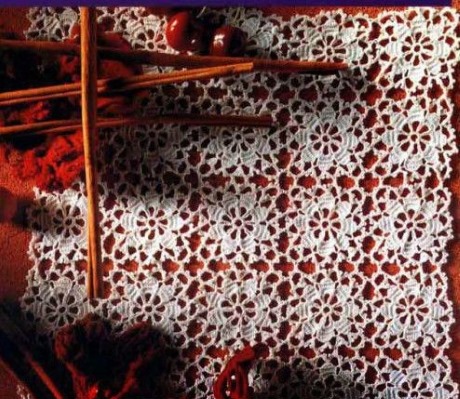
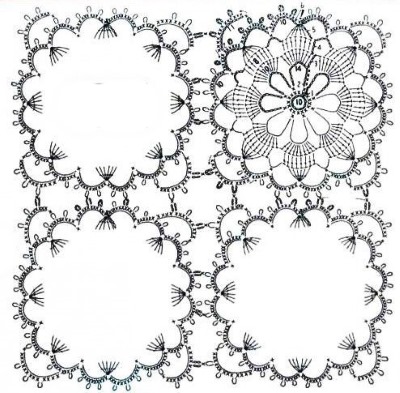
- Knit 5 SC into the arch formed by the VP of the 2nd row. Perform 3 CH of the lift, 9 double crochets (SC1H) into the arch. Under the loops of the next arch and all the other arches knit 10 SC1H. Finish the row with PSt.
- 3 VP to rise to the level of the next row, 8 ST1N, 5 VP, * 8 ST1N, 5 VP *. Repeat the description from * to * 6 times. At the end of the row, perform PSt.
- 4 CH for lifting, 5 ST1H with a common top, 10 CH, * 6 ST1H with a common top, 10 CH *. Repeat the description part from * to * 6 times and finish the row with PST.
- The final stage. It is necessary to carefully perform the corners and not forget when performing the picot, to connect the motif with the already finished elements. * 3 STbN, picot from 3 VPT *. Repeat this part of the description 3 times in the process of tying arch No. 1.
- Tie arch #2 in the same way. When tying arch #3 (motif corner), follow the instructions: 3 VP, 3 STbN, picot from 3 VP, 3 VPt, turn the work and knit 12 VPt, attach this chain to the middle of arch #2, turn the work and tie the just made chain in the same way as arches #1 and #2.
- Then finish tying arch #3: 3 STbN, picot of 3 VPT, 3 STbN. Tie arches #4, 5, 6, 8, 9, 10, 12, 13, 14 and 16 the same way as arch #1. Tie arches #7, 11 and 15 the same way as arch #3.
The good thing about a tablecloth made with such motifs is that it looks great even without a border.
Simple tablecloth for a rectangular table
Tablecloths for rectangular tables are usually crocheted using simple patterns - these are any grid patterns, basic patterns using the filet crochet technique or so-called "spiders".

Knitting a simple tablecloth:
- table measurements, calculations of the dimensions of the future product in centimeters;
- knitting a sample with the selected yarn and pattern (at least 3-4 rapports in width and about 10 cm in height);
- calculation of the product in loops and rows, determination of the number of rapports in width and height;
- set of air loops for the first row;
- knitting the tablecloth fabric with the selected pattern, according to the calculations made earlier;
- Finishing of the product. Binding with several rows of STbN. At the corners, it is necessary to knit 3 STbN from 1 base loop.
At the final stage, the tablecloth should be subjected to WTO.
Festive tablecloth
Tablecloths with openwork borders along the edges look elegant and festive.

Knitting such a product is quite simple:
- you need to make a simple tablecloth with any pattern or grid;
- the finished rectangle must be tied with several rows of STbN, this will align the contours and fix the shape of the product;
- tie the tablecloth with any border you like. It is worth knitting a sample of the border in advance and calculating how many rapports of the edging will be needed. If the full rapports "do not fit", then you can slightly change the width and height of the rectangular base.
Don't be afraid to adjust the tablecloth size to the pattern rapports. This will allow you to get a really neat and high-quality product.
Knitting patterns for decorative elements for tablecloths
If desired, the finished product can be decorated with additional decor:
- beads and sequins;

- embroidery;
- applique of crocheted flowers and leaves.
Patterns for small floral motifs, cones and spirals are easy to find, many of them are freely available. In a modern interior, a simple, single-color crochet tablecloth spread on a rectangular table is more appropriate, so it is important not to overdo it.
Author: Anna Ocean
Article formatting:Natalie Podolskaya
Video about crocheting tablecloth
Crochet tablecloth - knitting patterns:
https://www.youtube.com/watch?v=NxNBXUnechM

A tablecloth crocheted by hand is a good way to decorate a table, give the room a homey feel and a favorable atmosphere of inviting calm and comfort. I especially like the openwork options made of white yarn.